If you’re interested in options trading, then you need to know about open interest. In this article, we’ll explain everything you need to know about open interest, including what it is, how it’s calculated, and what it means for options traders.
What is open interest in options
When you buy or sell an option, you create what’s called an open interest position. Open interest is the total number of outstanding option contracts of a particular type (put or call) that have not yet been exercised or expired. It’s important to monitor open interest because it can provide clues about the future direction of the market.
When open interest decreases, it usually means that traders are closing their positions. This can be due to a number of reasons, but it generally indicates that traders are losing confidence in the current market trend. If open interest decreases while prices are rising, it could be a sign that the rally is about to end.
Conversely, when open interest increases, it means that more traders are opening new positions. This is often seen as a bullish sign, as it indicates that more traders are betting on prices going up. However, it’s important to remember that just because there is more open interest, it doesn’t necessarily mean prices will go up.
Open interest can also be used to confirm price movements. For example, if prices are rising and open interest is also increasing, that’s generally seen as a confirmation of the uptrend. Similarly, if prices are falling and open interest is also decreasing, that’s often seen as a confirmation of the downtrend.
While open interest can provide some valuable insights into the market, it’s important to remember that it’s just one piece of the puzzle. There are many other factors that can affect price movements, so don’t make any decisions based on open interest alone.
How is open interest used in options trading

Open interest is the number of outstanding contracts that exist for a particular security. Options traders use open interest to gauge market activity and liquidity. When open interest is high, it means there are a lot of traders interested in the security, and when it is low, it means there are fewer traders interested. Open interest can also be used to confirm price trends. If the price of a security is rising and open interest is increasing, it is an indication that the trend is strong and likely to continue.
What factors affect open interest in options
There are a few factors that affect open interest in options. The first is the price of the underlying security. If the price of the underlying security goes up, then call options will generally have more open interest than put options. The second factor is the time to expiration. The closer an option is to expiration, the more open interest it will generally have. The third factor is the volatility of the underlying security. The more volatile a security is, the more open interest it will generally have.
What is the difference between open interest and volume in options trading
When it comes to options trading, open interest and volume are two key metrics. Open interest refers to the number of outstanding contracts for a particular security or market. Volume, on the other hand, is the number of contracts traded during a given period.
So, what’s the difference between open interest and volume in options trading? Well, open interest can give you an idea of the liquidity of a particular market. The higher the open interest, the more liquid the market. Volume, on the other hand, can give you an idea of the activity level in a particular market. The higher the volume, the more active the market.
How can open interest be used to gauge market sentiment in options trading
Open interest can be used to gauge market sentiment in options trading by looking at the number of open contracts for each option. The higher the number of open contracts, the more likely it is that traders believe the price of the underlying asset will move in that direction.
What is the relationship between open interest and price in options trading

Open interest is the number of outstanding contracts that are held by traders at the end of the day. It is a measure of market activity and liquidity, and it can be used to identify trends in the market.
Price is the amount of money that one party is willing to pay for an option contract. The price of an option is determined by the market conditions at the time of the trade.
The relationship between open interest and price is not always linear, but there is generally a positive correlation between the two. When open interest is high, it means that there are more traders interested in the market, which can lead to higher prices. Conversely, when open interest is low, it can indicate that there are fewer traders active in the market, which can lead to lower prices.
Is high open interest a good or bad thing for options traders
Many options traders believe that high open interest is a good thing. They believe that it means there is more liquidity in the market and that it is easier to get in and out of trades. However, some options traders believe that high open interest can actually be a bad thing. They believe that it can lead to wide bid-ask spreads and that it can make it difficult to find buyers or sellers when you need to.
How can open interest help identify potential support and resistance levels in options trading
Open interest is the number of outstanding contracts on a security. It is used to identify potential support and resistance levels in options trading because it shows the level of activity in the market. Open interest can be used to identify potential support levels because it shows the number of contracts that are open and available to be traded. If there is high open interest, it means there is high demand for the contract and this can lead to prices rising. Similarly, low open interest can indicate a lack of demand and this can lead to prices falling.
What happens to open interest when an option contract expires
When an option contract expires, the open interest disappears.
How can open interest be used to determine whether an options market is active or inactive
Open interest is the number of open contracts for a particular security. It is used to determine whether an options market is active or inactive. If there is high open interest, it means that there are a lot of people trading the security and the market is active. If there is low open interest, it means that there are few people trading the security and the market is inactive.

